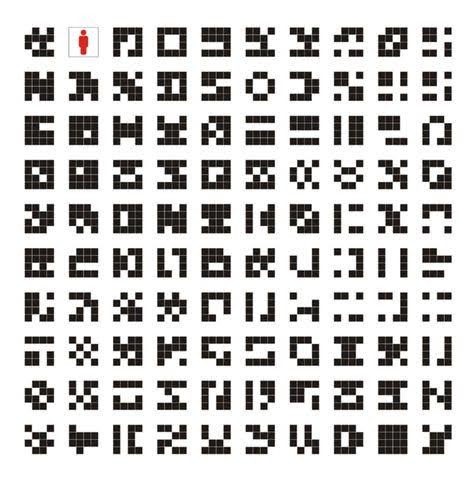A taxonomy of 4x4 patterns Thread
A TAXONOMY OF 4 X 4 tiles of 1 bit per pixels, according to symmetries. What symmetries am I counting?
- inverse of colors
- horizontal flip
- vertical flip
- 90 degree rotations.
- wrap-around offsets of the pixels (2 and 1 pixels, up and down making this 4 total mutations)
- the above in every possible combination
- sorted by the unique results.
first up, there’s two patterns that yield only two unique results after undergoing all of the above. Checkerboard, and pure black/white.

 0000
0000
2

 5a5a
5a5a
2
There is only one set that has 4 unique symmetries, and that’s stripes.
I like stripes. It’s not number one, but he’s a little trooper.the rebel. the loner. No one like her. Always changing their mind.



 0F0F
0F0F
4
coming out strong in the top of the group 8 patterns are halfchar and hatch. These are the workhorses. You could draw whole worlds with just these.



 00FF
00FF



 0FF0
0FF0
8, 00FF







 0505
0505
8
this one is amazing, it’s got 4 identities. it can be a not AND a cross, shift it a bit and you’ve got a double sized check. And third, you’ve got 4 directions of space ship. What an amazingly versatile pattern. imagine how much space you could save on your atari cart!

 33cc
33cc 
 6996
6996



 3cc3
3cc3
8, 33cc
As much as I love mx stripey, I love a jaunty angle, and here’s two. In some configurations we even get a space alien. or a chyron? could be lots of things. IMAGINATION.
and that concludes our group 8s..







 36c9
36c9
8, 36c9



 3c3c
3c3c



 5aa5
5aa5
8, 3c3c
Mx. Stripy! oh my! looks like you’ve had a stripe removed, and you’re doing a little dance.







 00F0
00F0







 000F
000F
16
Some strategically placed dots can be very handy for some dither patterns.











 0104
0104 














 0208
0208 


 050A
050A
16 16
what do I call these? I think CRENELATIONS is an appropriate term. Two groups of 16. you like zigs? you like zags? we’ve got both bases covered.
































16, 05F5 16. 05FA
amazing what you can do with just a single diagonal line, drawn from corner to corner.
or two. who’s counting?
oh that’s right. I am.



 2184
2184 






 1842
1842 


 1A4A
1A4A



 1842
1842 






 1248
1248 


 2585
2585
16 16
Look at these wide bois. they’re like delicious candy wrappers. Open up! just be careful how you arrange those squarish zig zags.
Believe it or not, that is every group 16 covered! there are many many more 32 groups.
34 of them to be exact. it’s a little unsatisfying really, that it isn’t 32.



 174d
174d 






 174d
174d 


 1e1e
1e1e



 1d47
1d47 






 1d47
1d47 


 2d2d
2d2d
16 16
so the breakdown of this categorization goes like this:
2 * 2
1 * 4
5 * 8
9 * 16
34 * 32
66 * 64
163 * 128
153 * 256
add that all together and you get 65536, every possible combination of 16 (4 x 4) bits.
I’m not sure how to tackle the rest of this taxonomy, because 433 groups is a lot to come up with silly names for.
This is basically like a puzzle with no solution. See patterns, decide what to do with them.
If I rerun my script without the shift symmetries, the breakdown works like this
8 * 2 = 16
28 * 4 = 112
400 * 8 = 3200
3888 * 16 = 62208
total: 4324 groups, 65536 tiles
so I can further categorise the original grouping by where the tiles inside land in this other grouping. Why? because for some reason I compulsively need to.
A single pale dot. the symmetries chosen happen to move it to every one of the 16 possible positions. it would be possible to index into this set of tiles, and xor the results to come up with every other possible tile.
It would be a silly format but sometimes silly ideas bear fruit if you allow them to grow.







 0001
0001







 0002
0002







 0002
0002







 0020
0020
32
Out of 65536 possible tiles, if I can only pick 4096 for my taxonomy, how do I pick them.
The method I am trying today is to use the outer 12 bitpixels as my index. Each index potentially represents one of 16 possible tiles out of the full 65536 set, with the middle 4 being up in the air.
if I use my earlier sorting by number of symmetries to group tiles by this index, I get rows of similar looking tiles, with more symmetrical looking tiles sorted to the left of each row.

The nature of this sorting can be drastically affected by switching to using the corner pixels as “wildcards” rather than the middle 4, and changing the number of symmetries that get counted in the ranking.



This sorting rule seems to be generating alien alphabets.

what is this image? where did it come from? how was this set chosen I wonder?

someone else helpfully put together the 512 3x3 patterns

i think I have a way to whittle down the field a bit. will need to write some code
my raw notes are at